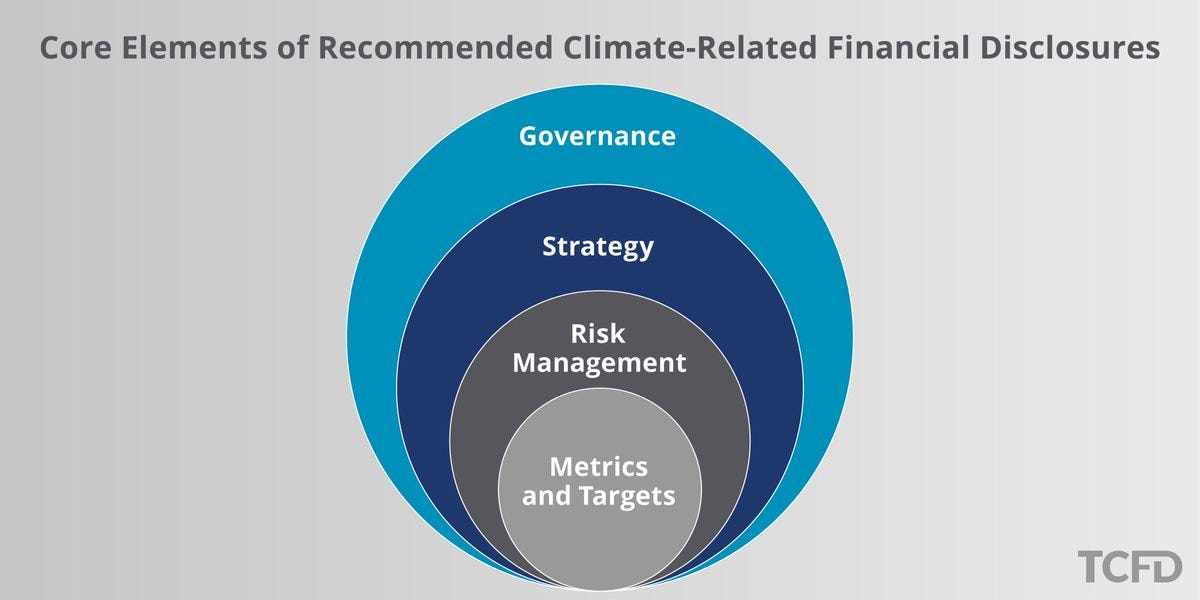TCFD: Task Force on Climate-Related Financial Disclosures
The SEC (United States Security and Exchange Commission) has proposed a rule to do with climate-related disclosures. The rule references many other documents from a wide variety of organizations. In the post SEC’s Climate Rule Background we list just a few of these organizations. In this post we provide more information to do with one of the most important of these organizations: the Task Force on Climate-Related Disclosures, or TCFD.
Background
The TCFD was created in 2015 by The Financial Stability Board (FSB)
. . . to develop recommendations on the types of information that companies should disclose to support investors, lenders, and insurance underwriters in appropriately assessing and pricing a specific set of risks—risks related to climate change.
It has the following goal.
Through widespread adoption [of financial transparency], financial risks and opportunities related to climate change will become a natural part of companies’ risk management and strategic planning processes. As this occurs, companies’ and investors’ understanding of the potential financial implications associated with transitioning to a lower-carbon economy and climate-related physical risks will grow; information will become more decision-useful; and risks and opportunities will be more accurately priced, allowing for the more efficient allocation of capital.
Disclosure Recommendations
The TCFD has developed recommendations that are,
. . . structured around four thematic areas that represent core elements of how companies operate: governance, strategy, risk management, and metrics and targets. The four recommendations are interrelated and supported by 11 recommended disclosures that build out the framework with information that should help investors and others understand how reporting organizations think about and assess climate-related risks and opportunities.
Recommendations Final Report
The TCFD has a task force that has published a Final Report: Recommendations of the Task Force on Climate-related Financial Disclosures. The recommendations are divided into four categories:
Governance,
Strategy,
Risk Management, and
Metrics and Targets.
For the non-financial sector the strategy section is divided into Energy, Transportation, Materials and Buildings, and Agriculture, Food, and Forest Products.
Opportunities
The TCFD recognizes that climate change is not all bad news. Table 2 in their report is entitled ‘Examples of Climate-Related Opportunities and Potential Financial Impacts’. The examples are divided into:
Resource Efficiency,
Energy Source,
Products and Services,
Markets, and
Resilience.
Scenario Analysis
The Final Report includes a section on scenario analysis, of which it says,
Scenario analysis is a process for identifying and assessing the potential implications of a range of plausible future states under conditions of uncertainty. Scenarios are hypothetical constructs and not designed to deliver precise outcomes or forecasts. Instead, scenarios provide a way for organizations to consider how the future might look if certain trends continue or certain conditions are met. In the case of climate change, for example, scenarios allow an organization to explore and develop an understanding of how various combinations of climate-related risks, both transition and physical risks, may affect its businesses, strategies, and financial performance over time.
Conclusions
The TCFD structure, along with that of the Greenhouse Gas Protocol, is foundational to the SEC’s proposed rule. It is also foundational for many of the companies who do not fall under the SEC’s jurisdiction but who wish to prepare a climate-related financial analysis.
It is encouraging to see that they have a section on opportunities. One of the themes of this site is that leadership to do with climate action will come from business and industry. Many companies — maybe most of them — will not meet the challenges that climate change will create. But a few — those who are most adaptable — could prosper if they make the right climate decisions.





